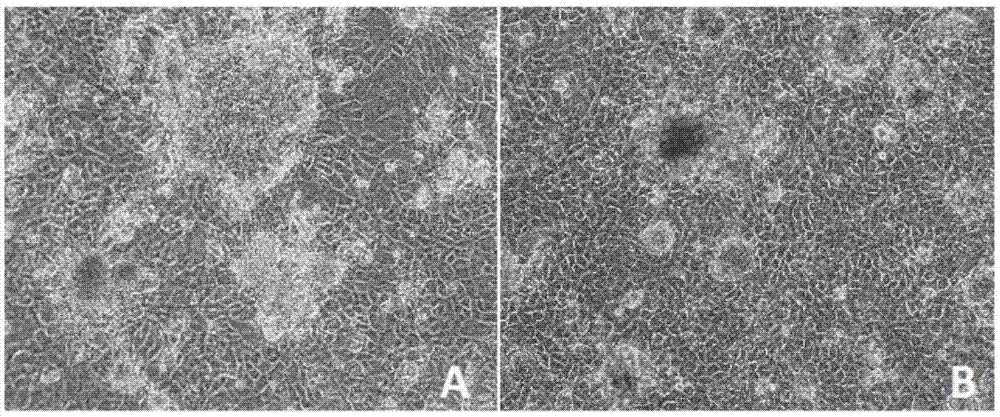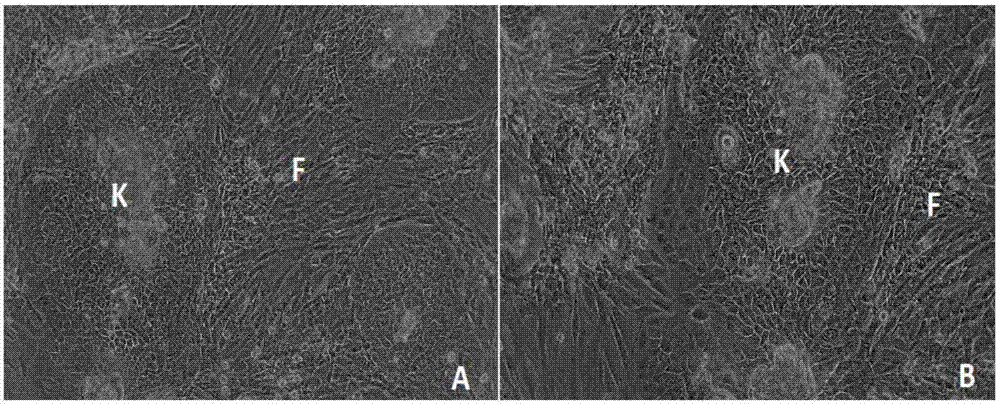A wound-adhesive artificial active tissue constructed with serum-free and bovine pituitary extract culture fluid and its construction method
A technology of bovine pituitary gland and culture fluid, which is applied in the fields of tissue engineering and medical wound repair, which can solve the problems of unsatisfactory product timeliness, and achieve the effects of skin regeneration, avoiding immune rejection, and high cell activity
- Summary
- Abstract
- Description
- Claims
- Application Information
AI Technical Summary
Problems solved by technology
Method used
Image
Examples
Embodiment 1
[0045] Embodiment 1 cell culture fluid preparation
[0046] Cell culture medium A (artificial tissue fibroblast culture medium): use basic culture medium DMEM (HyClone, USA), add penicillin and streptomycin dual-antibody 1~5000U / ml in the basic culture medium DMEM;
[0047] Cell culture medium B (artificial tissue epidermal cell culture medium): composed of the following substances by volume percentage: basic culture medium DMEM 60% to 85%; basic culture medium HAM's F-12 (ScienCell, USA) 10% to 40%; Composition 5%~15%: penicillin, streptomycin double antibody 1~5000U / ml; amphotericin B 0.5~6000ng / ml; adenine 0.06~370ng / ml; insulin 0.02~530ug / ml; hydrocortisone 0.05 ~490ug / ml; triiodothyronine 0.03~280ng / ml; transferrin 0.07~460ug / ml; the sum of the three volume percentages is 100%, and the above culture medium DMEM and HAM's F-12 are added according to the formula Corresponding volume of liquid, penicillin, streptomycin double antibody, amphotericin B, adenine, insulin, hydroc...
Embodiment 2
[0048] Example 2 Separation and cultivation of dermal fibroblasts
[0049] 1) Materials:
[0050] Human fibroblasts can be derived from a variety of tissues including, but not limited to, male neonatal foreskin, dermis, tendon, lung, umbilical cord, cartilage, urethra, corneal stroma, oral mucosa, and intestine. Cell donors can vary in development and age, and cells can be derived from neonatal or older individuals, including adult donor tissues, such as mesenchymal stem cells, that can be used in the present invention and induced to differentiate into the desired tissue. Fibroblasts are preferably male neonatal foreskin and autologous skin.
[0051] The epithelial source isolated by surgery was placed in sterile saline and sent to the cell culture room.
[0052] 2) digestion
[0053] Carefully remove subcutaneous fat tissue, fascia and capillaries with scissors, rinse twice with phosphate-buffered saline (1×PBS), cut into about 0.5 cm strips, and soak in 0.05% trypsin at 4...
Embodiment 3
[0058] The separation of embodiment 3 epidermal cells
[0059] 1) Materials:
[0060] Human epidermal cells can be derived from a variety of tissues including, but not limited to, male neonatal foreskin, dermis, tendon, lung, umbilical cord, cartilage, urethra, corneal stroma, oral mucosa, and intestine. Cell donors can vary in development and age, and cells can be derived from neonatal or older individuals, including adult donor tissues, such as mesenchymal stem cells, that can be used in the present invention and induced to differentiate into the desired tissue. Human epidermal cells can be selected from body skin or allogeneic skin.
[0061] The epithelial source isolated by surgery was placed in sterile saline and sent to the cell culture room.
[0062] 2) digestion
[0063] Carefully cut off the subcutaneous fat tissue, fascia and capillaries with scissors, rinse twice with 1×PBS, cut into strips of about 0.5 cm, and soak in 0.05% trypsin at 4°C overnight.
[0064] 3)...
PUM
 Login to View More
Login to View More Abstract
Description
Claims
Application Information
 Login to View More
Login to View More - R&D
- Intellectual Property
- Life Sciences
- Materials
- Tech Scout
- Unparalleled Data Quality
- Higher Quality Content
- 60% Fewer Hallucinations
Browse by: Latest US Patents, China's latest patents, Technical Efficacy Thesaurus, Application Domain, Technology Topic, Popular Technical Reports.
© 2025 PatSnap. All rights reserved.Legal|Privacy policy|Modern Slavery Act Transparency Statement|Sitemap|About US| Contact US: help@patsnap.com



